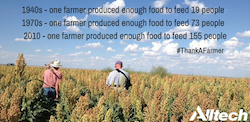 Alltech Crop Science is paying tribute to farmers and food producers around the world who continue to find ways to feed the ever-growing population to commemorate the United Nations World Food Day, Oct. 16, 2015. There are now approximately 7.3 billion people living off the same amount of farmland compared to that in the 1970s.
Alltech Crop Science is paying tribute to farmers and food producers around the world who continue to find ways to feed the ever-growing population to commemorate the United Nations World Food Day, Oct. 16, 2015. There are now approximately 7.3 billion people living off the same amount of farmland compared to that in the 1970s.
What do you do when the global population doubles, but the world’s farmland is finite?
U.S. farmers provide 20 percent of the world’s food using only 10 percent of its land. American farmers produce six times more corn with 20 percent less land compared to their peers of the 1930s. The average corn yield grew from 39 bushels per acre in 1950 to 153 bushels per acre in 2000. Between 1961 and 2005, average cereal yields increased 155 percent. As productivity has improved, so have techniques for sustaining resources. Farmers have become more efficient, allowing the burgeoning population to continue reaping natural resources from the land.
“Farmers are pretty amazing,” said Robert Walker, Alltech Crop Science general manager. “They have to be part agronomist, conservationist, meteorologist and economist. Alltech Crop Science wants you, the consumer, to join us on World Food Day to thank farmers around the world (#ThankAFarmer) for continuing to produce natural, healthy produce.”
In the last decade consumption has increased significantly. Demand for meat has tripled in the developing world in the past four decades, while egg consumption has increased sevenfold. We have also seen an increase in the demand for soybeans (48 percent), corn (37), rice (14) and wheat (13).
“Food production alone must increase by 70 percent, which means we have to produce more food in the next 50 years than that of the past 10,000 years combined,” said Walker. “Alltech Crop Science follows the seed, to feed, to fork, to future mentality. It is about taking a holistic, integrated approach to sustainable production. Producers and farmers must focus on nutrient efficiency and end-product quality as consumer demand rises, while identifying the environmental challenges.”
